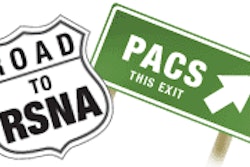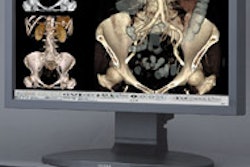Evaluating PACS technology at the annual RSNA meeting is no an easy task, complicated as it is by the dizzying array of choices facing prospective purchasers. Vendors are prone to making the job even harder by showcasing technologies that, in a best-case scenario, are either months away from release or light-years away from becoming reality (if even then).
Companies are notorious for showing one version of software, yet delivering another. What's sad is that a majority of buying decisions made at RSNA are based on what is seen in a demo or even in an onsite demo, versus seeing what is actually deliverable in a clinical setting.
So how do you evaluate PACS at RSNA? With both eyes open and a high degree of skepticism. It's important to be aware that what you're seeing may not be what you're getting, unless you're just starting the evaluation process and are at least a year away from implementation.
This doesn't mean you can't do a proper evaluation of PACS at RSNA, but be somewhat cynical of whatever you see, and take everything with a grain of salt. Here are a few tips to help you get through RSNA 2004:
What you see probably isn't what you'll get. Vendors almost always highlight their latest and greatest software releases at RSNA. While the software may not be ready for prime time (or commercial release), it's fine to see what's coming next, provided the products are promoted that way. You will no doubt implement the current commercial release (typically one version back from what you're seeing), but you should always negotiate for a free upgrade to the next release (what you see at RSNA) at no charge. The savvy buyer will carry this one step further and negotiate two releases (upgrades, not updates) at no charge, paying only for the software installation, which still will cost you $10,000 to $15,000.
Never schedule a demo during show hours. Unless you enjoy having 35 people you've never seen before joining in (or intruding on) your demo, and asking inane questions (in five different languages) that have absolutely no relevancy to your clinical operations, don't even consider a demo during show hours. Instead, schedule a demo before (much preferred) or after show hours. Have a company rep meet you at an entrance (security won't let you in before the show opens without an escort), and budget at least an hour for the demo.
If you want the truth, ask an engineer. Most engineers really don't know how to lie, which is why I love talking with them so much. When you ask an engineer a question, you usually get an honest answer. It may not be anywhere close to the answer you got from the salesperson, but at least you know it's the truth.
Look for grayed-out sections in software. Want to discern fact from fiction with diagnostic workstation software? Look for the grayed-out sections, which typically are software features that don't work yet, or at all in some cases. Want to have even more fun? Put the mouse over the grayed-out area and your finger on the right click button without hitting it, and then look around for the guy whose face turns ghost white. He's the workstation software development engineer.
Don't hesitate to look beyond the majors. Certain companies became
industry leaders for a reason, but there are just as many solutions from
smaller players that will work. Make sure you look at all possible solutions
from large and small players alike. You may be amazed at just how good a fit
some smaller players really are.
Know your requirements. Trying to evaluate PACS vendors without a clear-cut understanding of your requirements is like bringing a kid into a candy store and telling him he can only spend a dollar. It can be done but it is not easy, and takes loads of time and patience from you and the vendors trying to help you. If you don't know or haven't taken the time to clearly articulate what your needs really are (preferably on paper), don't waste your time or the vendors'.
Make your intentions known. If you don't have a budget approved by your board for PACS and think PACS is most likely a reality for your institution in fiscal year 2006-2007, please don't monopolize the vendors' time at RSNA. Read articles and look around to get familiar with the technology, but making it seem like you're on the cusp of purchasing when you aren't isn't fair to the vendors who would rather focus on those who will be buying now.
If you want to make a deal, come midweek. The executives from the larger vendors always show up Monday or Tuesday, and stay a day or so to give their apostolic blessing to the investments made in the show. So if you're talking big bucks (more than $5 million) and want a few more concessions, it's best to schedule serious negotiations midweek. Sunday mornings are usually slow, and activity picks up and peaks Monday and Tuesday. By Wednesday afternoon, it slows down again some. Thursday mornings are generally times when vendors demo their products to other vendors, and by Thursday afternoon you can generally bowl down the aisles and not hit anyone.
Don't play games. As above, if you have narrowed your decision down to two vendors, and will be making the decision by year's end (or shortly thereafter), let them know. Saying you're not sure who the finalists are can actually hurt you, as the people who can answer your questions might be pulled away to assist others who the vendor feels are closer to making a decision. Also, recognize that this is a very small industry; everyone pretty much knows what's going on, so you only look like a fool playing games.
Understand RSNA is a radiology-centered show. It's great that you brought four people from your information technology (IT) department to help you evaluate PACS. Unfortunately, most of them will be completely lost in the RSNA environment, just as you probably would be at the Healthcare Information and Management Systems Society (HIMSS) meeting. Next time, save the IT folks to help you with the evaluation of things near and dear to them, such as what it takes to do the clinical interfaces, service, and integration requirements, as well as network issues and the like. These are all best handled with onsite visits and phone calls.
Best of breed works -- if you choose the right solution. Not every vendor has everything you want or need. If a vendor offers you two computed radiography (CR) choices, and you prefer one not being offered, don't hesitate to buy it from the other vendor directly. Most CR units fit in the DICOM "plug and play" category, at least to the limit that all devices are plug and play. Likewise, you are better served buying the best radiology PACS from the best radiology PACS provider, the best cardiology PACS from the best cardiology PACS provider, etc. The same holds true with online archive options and even disaster recovery schema; just make sure the vendor you plan on buying your PACS from will (or has) worked with them.
IHE is a great concept, but … You'll see multiple demonstrations of intervendor and intersystem connectivity all under the Integrating the Healthcare Environment (IHE) banner. The IHE concept is admirable and plays a huge part in the future of PACS, but the reality, like DICOM in its early days, is that it still takes a whole lot more than plug and play to really make it work.
Everyone is number one. As you go around the show floor, almost every
company will proclaim their current or prior status as the number-one-rated
company. Over a dozen companies can lay claim to having won the top prize in
the past few years alone. Three different PACS vendors are currently identified
as the number-one PACS company by three different evaluating companies, so take
PACS rankings with a grain of salt: Those at the top may be further down the
next ranking period, and those further down may be back up top again.
"We can do that." Have you ever seen a bad image at RSNA?
Similarly, very few vendors will say no to something you ask for (unless it's
an engineer, then he'll not only say no, but explain in great detail why it
can't be done). If you are told something can be done at RSNA, make sure you
have at least three witnesses who can corroborate the statements made, then
follow up by getting the details in writing -- and signed by the national sales
manager.
Have an exit strategy before you say "I do." Donald Trump
and Madonna have protected themselves with prenuptial agreements, and you
should too. Database and data migration strategies need to be discussed in
detail with the vendor, because while you may enjoy the newlywed phase now,
reality sets in after a while. The typical PACS network is replaced every five
years or so (about as long as some marriages), so even with the best PACS you
need a migration and exit strategy. Make sure you ask lots of questions
relating to this, especially if the vendor is archiving the data and is only
keeping a few months on RAID.
The only mistake you can make is not making a decision. The amount of information you'll get at RSNA will leave you numb, with information overload taking over. It's easy to walk away more confused after going to the show than before. Don't let that dissuade you from making a decision. Understand that you'll always second-guess yourself, and the losing vendors will second-guess you as well. Don't let it faze you. It's all a part of this crazy thing called RSNA. If you go to RSNA with an open mind, you'll be fine. The worst decision you can make is making no decision simply because you're more confused now than you were before. Have a plan, set your focus on getting specific questions answered, and have fun.
By Michael J. Cannavo
AuntMinnie.com contributing writer
November 18, 2004
Michael J. Cannavo is a leading PACS consultant and has authored nearly 300 articles on PACS technology in the past 15 years. He can be reached via e-mail at [email protected].
Mr. Cannavo will be at RSNA this year and should be easily recognized, as no one will stand near him lest the bullets with his name on them miss their mark. He will be compiling the Fourth Annual PACSman awards, which will be posted on AuntMinnie.com from the RSNA show floor. Part V of the PACS secrets series will follow in mid-December.
The comments and observations expressed herein do not necessarily reflect the opinions of AuntMinnie.com, nor should they be construed as an endorsement or admonishment of any particular vendor, analyst, industry consultant, or consulting group. Rather, they should be taken as the personal observations of a guy who has, by his own account, been in this industry way too long.
Related Reading
Part III: Exploring PACS secrets, September 17, 2004
Part II: Exploring PACS secrets, July 6, 2004
Part I: Exploring PACS secrets, May 14, 2004
PACS still a bridesmaid at HIMSS, February 27, 2004
The year of the Uni-PACS: A view from the RSNA floor, December 11, 2003
The PACSman's opinionated view from RSNA 2003, December 4, 2003
Copyright © 2004 AuntMinnie.com



















